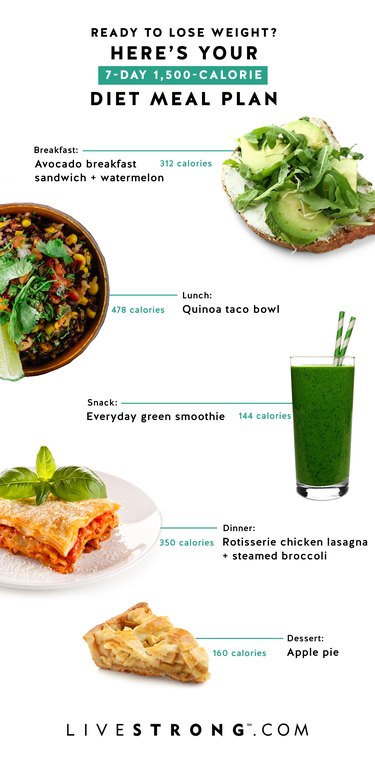
Cutting back on calories is the first and foremost step you have to take in order to lose weight. While aiming for 1,500 calories a day is a popular target that may help you drop the pounds, it's only as effective as the quality of your overall meal plan.
If you're paring down your food intake to just 1,500 cals a day, choosing the right foods and making every bite count will help you stay satiated while reaching your weight-loss goals.
Step 1: Ask an Expert
If your goal is to lose weight or change your diet to manage a health condition, it's wise to talk to your doctor and seek the advice of a dietitian. A dietitian can design a food plan that merges your specific energy needs, food preferences and can adapt this plan to manage any health conditions or reduce health risks. You can also get guidance on how to complement your low-calorie diet with supplements, if necessary.
A 1,500-calorie diet plan may help you succeed — as long as this calorie level helps you achieve gradual, safe weight loss, and take your exercise habits into consideration. According to the Centers for Disease Control and Prevention (CDC), dropping 1 to 2 pounds a week is most associated with long-term success.
So if following a 1,500-calorie plan makes you hungry or weak — or even if this plan leads to rapid weight loss — then you probably need more calories or more balance in your diet. On the other hand, if you are following a 1,500-calorie weight loss plan and not losing weight, perhaps you need fewer calories — but more exercise and a better balanced diet could help as well.
Step 2: Make a Plan
Most dietary calories come from carbohydrates, proteins and fats, and everyone's diet gets a certain amount of energy from each of these macronutrients. While the optimal diet — whether low or high in carbs or low or high in fat — is hotly disputed, the National Academy of Sciences provides fairly flexible guidelines for how much of these macronutrients can be found in a healthy diet.
According to the guidelines, a healthy meal plan can contain between 45 to 65 percent of its calories from carbohydrates, 20 to 35 percent from fats and 10 to 35 percent from protein. So a 1,500-calorie plan can contain fairly wide ranges of these macronutrients — between 160 to 244 grams of carbohydrates, 33 to 58 grams of total fat and 38 to 131 grams of protein.
Thankfully, weight loss success isn't solely dependent on counting and measuring! Diet quality matters, too, as illustrated in a yearlong study published in the February 2018 issue of JAMA. Researchers found that whether study participants followed a low-carbohydrate or low-fat diet, those who ate more vegetables and reduced their dietary intake of added sugars and highly processed foods lost more weight. These findings echo the key messages in the 2015-2020 Dietary Guidelines for Americans, which define an optimal diet as one that includes a variety of nutrient-rich foods within a healthy eating pattern — rather than a restrictive or difficult-to-follow diet.
Step 3: Grocery Shop
An important strategy for weight loss success is to plan ahead. The Academy of Nutrition and Dietetics recommends you:
- Make a grocery list according to your upcoming planned meals and snacks.
- Stock your pantry, fridge and freezer with foods from each of the five food groups.
- Stick to your list when shopping.
Don't forget to stock up on fruits and vegetables and add lower-calorie, nutrient-dense foods to most of your meals and snacks. Fresh and frozen produce is a great choice, although canned tomatoes, canned beans, light canned fruits and dried mushrooms are good pantry staples, too — just make sure they're low in sodium and added sugar! Keep whole grains, such as oatmeal, barley, quinoa, farro and brown rice on hand.
Read more: Fresh vs. Frozen Produce: Which Is Healthier?
You'll also want to add healthy protein sources to your shopping list, such as unsalted nuts, seeds, dried beans, and lean proteins such as fish, shellfish, tofu, chicken and lean cuts of beef or pork. Canned tuna, salmon and sardines are also great pantry staples, not to mention, an easy way to add both protein and flavor to meals.
Toss calcium-rich foods including low-fat or fat-free milk, low-fat cottage cheese, plain or light yogurt, or unsweetened soy, cashew or almond milk into your cart, too. Keep fresh herbs, vinegar and your favorite spices on hand to keep your meals full of flavor, and have some healthy oils on hand for moderate use in salads or cooking, such as extra virgin olive oil.
A 7-Day 1,500-Calorie Meal Plan
While your meal plan can probably fit moderate portions of many of your favorite foods, sample menus are a helpful tool that can add variety or reinforce portions. Our weeklong sample menu illustrates the portions found in a 1,500-calorie plan, but you can totally tweak it according to your taste preferences and diet restrictions.
When it comes to what you're sipping, stick to water, unsweetened hot or iced tea or sparkling water. Coffee is also acceptable in moderation — as long as you don't douse it with cream, syrups or sugar! (And yes, that means you'll have to lay off the Frappuccinos, too.)
Tip
For linked recipes, pay attention to the serving size and the servings the recipe makes — since the correct portion is one serving. Also, low-calorie diets may not provide the correct amount of vitamins or minerals to meet your body's needs. Speak with your dietitian or doctor to understand which vitamin or mineral supplements are right for you.
Monday
Breakfast (489 calories)
Lunch (476 calories)
Snack (77 calories)
- 1 small apple
Dinner (392 calories)
- Simple Dijon Salmon
- 1 cup baked acorn squash
- Creamy Vegan Spinach
- 1 cup cantaloupe
Snack (64 calories)
Tuesday
Breakfast (400 calories)
- Kiwi Yogurt Breakfast Bowl
- 1 slice whole-wheat toast with 1 tablespoon peanut butter
Lunch (432 calories)
Snack (160 calories)
Dinner (430 calories)
Snack (78 calories)
Wednesday
Breakfast (330 calories)
- Smoked Salmon Breakfast Sandwich
- 1/2 medium banana
Lunch (421 calories)
Snack (150 calories)
Dinner (530 calories)
Snack (73 calories)
Thursday
Breakfast (322 calories)
- Egg, Spinach and Portobello Breakfast Sandwich
- 1 cup sliced strawberries
Lunch (567 calories)
- Mexican Turkey Soup
- 1 cup diced mango
Snack (80 calories)
Dinner (343 calories)
- Roast Pork Tenderloin
- 1/2 cup baked yam
- Asparagus with Grated Parmesan
- 1/2 cup sliced pears
Snack (193 calories)
Friday
Breakfast (353 calories)
- Walnut Yogurt
- 1 cup mixed berries
Lunch (429 calories)
- Indian Sweet Potato Edamame Stew
- Autumn Spinach Salad
- 1/2 cup honeydew melon
Snack (102 calories)
- 1 medium nectarine
- 5 almonds
Dinner (573 calories)
Snack (64 calories)
- 1 cup raspberries
Saturday
Breakfast (362 calories)
Lunch (428 calories)
- Tofu Vegetable Soup
- Citrus Greens Salad
- 1 cup sliced peaches
Snack (102 calories)
- 1 cup grapes
- 10 pistachios
Dinner (553 calories)
- Roasted Beef with Potatoes and Broccoli
- Caesar-Style Kale Salad
- 1 small orange
Snack (67 calories)
Sunday
Breakfast (312 calories)
- Avocado Breakfast Sandwich
- 1 cup watermelon
Lunch (478 calories)
Snack (144 calories)
Dinner (350 calories)
- Rotisserie Chicken Lasagna
- 1/2 cup steamed broccoli
Snack (160 calories)
Warning
If you are under a doctor's care for any medical conditions, seek advice before starting a restrictive diet. Also, if your child or teen is overweight, do not place your child on a diet. Instead, discuss healthy weight strategies with his or her doctor.
Read more: 10 Cooking Tips Every Beginner Chef Must Know
Expect Barriers and Know How to Overcome Them
When you're doing your best to slash your daily calorie intake, cravings and hunger can hamper your efforts. To counter this, Malina Malkani, RDN, spokesperson for the Academy of Nutrition and Dietetics and creator of the Wholitarian Lifestyle, suggests incorporating more high-volume, low-calorie foods, such as soups, salads, vegetables and fruits. She also recommends eating balanced meals, drinking plenty of water and incorporating other high-fiber foods, such as whole grains, beans and lentils.
Consuming high-calorie foods of low nutritional value can also get in the way of your progress. So stay away from sugar-sweetened beverages, including sodas and sugary coffee drinks, and cut back on fried foods, desserts, candies and snack chips. "If you choose to restrict calories, it's important to make every bite count," Malkani tells LIVESTRONG.com.
But even when you're diligent about cutting back on calories, you won't necessarily drop weight at the same speed your friend on the same diet does.
"Fat loss relies on a myriad of factors in addition to the energy value of the diet," Moe Schlachter, RD and spokesperson for the Texas Academy of Nutrition and Dietetics and president of Houston Family Nutrition, explains. "These factors include the nutritional quality of the diet along with energy exertion, stimulation of fat cells, hormone signaling, age, sex, disease, medication, genetics, and so much more."
While the popular school of thought states that if a person created a calorie deficit of 500 calories daily (by eating less and exercising more) they could lose 1 pound a week — but weight loss isn't that predictable. While some people can lose 5 pounds in just a few weeks, it can take others a few months to lose the same amount. Calorie targets in a meal plan can help give portion size estimates, according to Schlachter. But he clarifies, "These calorie targets should not be used as a primary benchmark of a diet's capacity to foster weight loss."
Even with a high-quality, calorie-restricted diet, it can be challenging to lose weight unless your physical activity is also increased. And exercise is important on a 1,500-calorie diet, according to Schlachter.
"If exercise is the mission, then the calorie target (and nutritional quality of the diet) should be designed to support adequate activity." Aim to include 250 minutes a week of exercise in order to boost your odds of weight loss success.
Read more: How to Build a Weekly Healthy Meal Plan on a Budget
